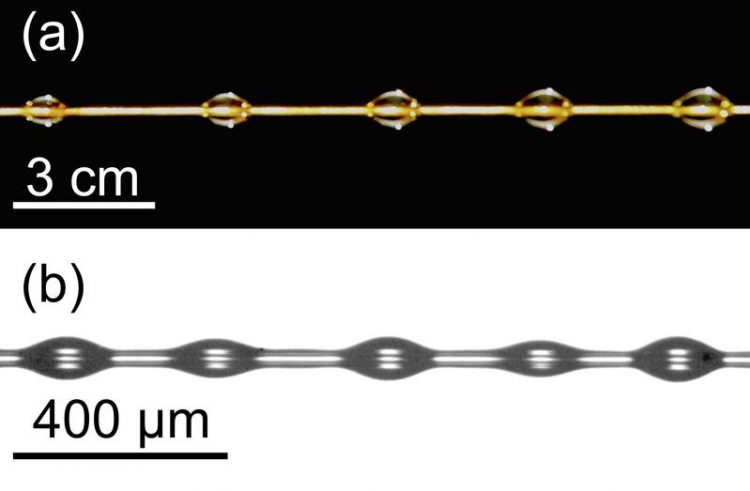Liquids on Fibers – Slipping or Flowing?

Ein homogener Honigfilm auf einem Faden zerfällt aufgrund der Plateau-Rayleigh-Instabilität in einzelne Tröpfchen (a), ebenso wie der im Modellsystem untersuchte Lackfilm auf einer Glasfaser (b). Foto: H. und S. Haefner und AG Jacobs (Universität des Saarlandes).
Thin fibers play a tremendous role in daily life, from the use of glass fibers in ultra-fast data transmission to textile fibers. In order to enable special properties of these fibers, they are often coated with a thin liquid layer that is supposed to be stable and homogeneous.
However, for the production of drinkable water, the exact opposite features are desired: there, one aims at harvesting water, which is transported along the fiber as a liquid film or as liquid droplets, from fog. Now, scientists have been able to reveal whether liquid films slowly flow along the fiber or if they can slip faster on the fiber.
The team composed of Karin Jacobs and Sabrina Haefner from Saarland University, together with Oliver Bäumchen from the Max Planck Institute for Dynamics and Self-Organization in Göttingen, and colleagues from Canada and France have been able to show for the first time, by means of novel experiments and mathematical models, how a liquid film moves on a fiber, depending on the fiber coating. The results of this study have now been published in the high-ranked journal “Nature Communications”.
Many examples for liquids on fibers are known in nature. Just think about dew droplets on spider webs that you can observe during a walk in the morning. Indeed, humidity is collected on the fiber as droplets, as the liquid surface can be minimized this way. This phenomenon, which can also be observed for a stream of water flowing out of a faucet, is named the Rayleigh-Plateau instability.
“All systems drive towards their energetic minimum, and that is the droplet shape in this case”, says Sabrina Haefner, a physicist in the research group of Karin Jacobs. This instability can be very useful in very dry and remote regions of the world. For example, in Chile’s Atacama desert, the acquisition of drinkable water is essential for the locals and they harvest water from the humidity by means of fiber nets.
In industrial applications, however, it is often necessary to realize stable and homogeneous liquid films on fibers. So how does one manage to avoid this droplet formation? “The surface energy of the liquid, its viscosity, the thickness of the liquid film, as well as the diameter of the fiber, play an important role”, explains Karin Jacobs. The international team of researchers has now found that the properties of the fiber itself also have a strong impact. “The contact between the liquid and the fiber is indeed very important”, says Oliver Bäumchen from the Max Planck Institute for Dynamics and Self-Organization.
“If the liquid slips on the fiber surface, the droplet formation is much faster than in the case of just flow along the fiber”. The team of physicists tested this for liquid films supported by uncoated and Teflon-coated fibers. On uncoated fibers, the liquid film moved rather slowly, and droplet formation took longer, than on coated fibers, where the liquid film was able to slip. “In line with mathematical models, these experiments allow for quantifying ’slippage’ of liquid films and to precisely predict the dynamics of the droplet formation process”, says Sabrina Haefner from Saarland University. The team of researchers agrees: Their results are very important for the design of novel fiber coatings.
The international team of researchers is composed of experimental and theoretical physicists from Saarland University (Saarbrücken, Germany), the Max Planck Institute for Dynamics and Self-Organization (Göttingen, Germany), McMaster University (Hamilton, Canada) and the ESPCI (Paris, France).
The study by S. Haefner, M. Benzaquen, O. Bäumchen, T. Salez, R. Peters, J.D. McGraw, K. Jacobs, E. Raphaél, and K. Dalnoki-Veress with the title “Influence of Slip on the Plateau-Rayleigh Instability on a Fibre“ has been published in the high-ranked journal “Nature Communications”:
http://www.nature.com/ncomms/2015/150612/ncomms8409/full/ncomms8409.html
A picture from the study can be downloaded here: http://www.uni-saarland.de/pressefotos
A video from the study can be found here: https://www.youtube.com/watch?v=jxEUfXvQ_Ms
Contact:
Prof. Dr. Karin Jacobs
Saarland University, Experimental Physics
Tel.: 0049 – 681 302-71788
E-Mail: k.jacobs@physik.uni-saarland.de
http://www.uni-saarland.de/jacobs
Dr. Oliver Bäumchen
Max Planck Institute for Dynamics and Self-Organization Göttingen
Tel.: 0049 – 551 5176-260
E-Mail: oliver.baeumchen@ds.mpg.de
http://www.dcf.ds.mpg.de
Media Contact
All latest news from the category: Physics and Astronomy
This area deals with the fundamental laws and building blocks of nature and how they interact, the properties and the behavior of matter, and research into space and time and their structures.
innovations-report provides in-depth reports and articles on subjects such as astrophysics, laser technologies, nuclear, quantum, particle and solid-state physics, nanotechnologies, planetary research and findings (Mars, Venus) and developments related to the Hubble Telescope.
Newest articles

NASA: Mystery of life’s handedness deepens
The mystery of why life uses molecules with specific orientations has deepened with a NASA-funded discovery that RNA — a key molecule thought to have potentially held the instructions for…

What are the effects of historic lithium mining on water quality?
Study reveals low levels of common contaminants but high levels of other elements in waters associated with an abandoned lithium mine. Lithium ore and mining waste from a historic lithium…

Quantum-inspired design boosts efficiency of heat-to-electricity conversion
Rice engineers take unconventional route to improving thermophotovoltaic systems. Researchers at Rice University have found a new way to improve a key element of thermophotovoltaic (TPV) systems, which convert heat…



